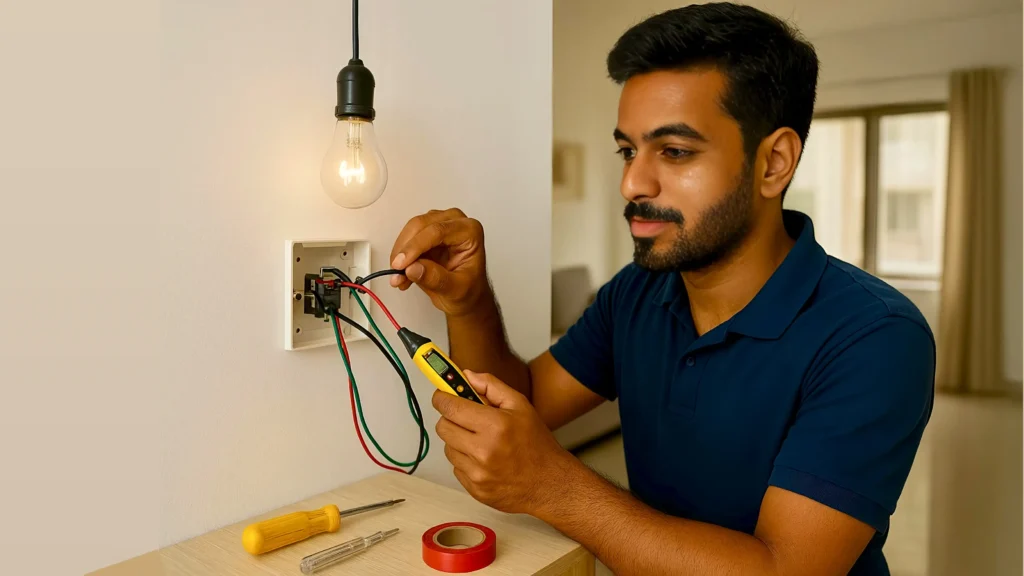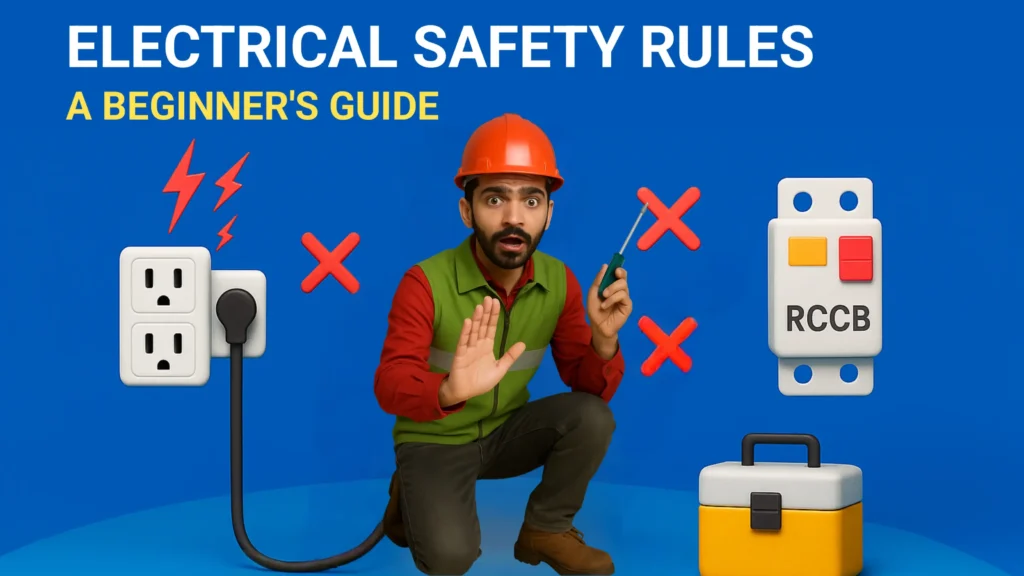
Wiring Basics Introduction to House wiring basics in India – wiring types, wire sizes, color codes, connections, safety tips, and mistakes to avoid, with easy diagrams
Wiring Basics Introduction to House Wiring
Welcome back to our Electrical Learning Series!
If you’ve been following along, you already know the basics we covered in Level 1:
- Part 1: What is Electricity? – A Beginner’s Guide
- Part 2: Electrical Safety – A Beginner’s Guide
- Part 3: Basic Electrical Tools and Their Uses
Now that you know what electricity is, how to stay safe, and which tools to use, it’s time to see them in action. In this post, we’ll cover the basics of house wiring — including types of wires, wiring systems, simple connections, and beginner-friendly tips to help you understand how your home’s electrical system works.
Now that you’ve got your toolkit sorted and know how to handle those tools safely, it’s time to put them to work. Today, we’re tackling the fundamentals of house wiring. We’ll break down the types of wires you’ll encounter, walk through some simple wiring connections, and share beginner-friendly tips to help you get started with confidence. Trust me, wiring doesn’t have to be intimidating—it’s like learning to cook; once you know the ingredients and basic recipes, you can whip up something functional (and safe!).
This is Level 2 (Part 4) of our series, designed for beginners who want to take their first steps into practical wiring. By the end of this guide, you’ll understand:
✔ Different types of wires & their uses
✔ Basic wiring connections
✔ Safety precautions while working with wiring
✔ Beginner-friendly tips to avoid mistakes
By the end of this post, you’ll have a solid grasp on house wiring basics, and you’ll be ready for our next installment: “1-Way Switch Connection” in Part 5. We’ve got more parts coming up too, like advanced circuits and troubleshooting, so stick around. Let’s dive in!
And yes, we’ll keep it simple, conversational, and easy to follow—just like a friend explaining it to you over chai! ☕
⏩ Let’s start with Wiring Basics Introduction to House Wiring
Before we discuss the basic introduction of house wiring: we must know what is house wiring?
What is House Wiring?
House wiring is the network of electrical cables, switches, sockets, and safety devices that distribute electricity throughout your home. In simple words — it’s how electricity travels from the main supply to all your appliances and lights.
In India, electricity usually comes from:
- Power Company Supply →
- Energy Meter (installed outside the house) →
- Main Distribution Board (MCB + RCD) →
- Wiring inside your home →
- Switchboards & Sockets →
- Appliances, lights, fans, etc.
💡 Pro Tip: Always remember that house wiring is like the blood vessels of your home — keep them healthy, and everything works smoothly.
Types of Wiring Systems in India
There are several ways to connect electrical circuits in a home. Here are the most common wiring systems used in Indian houses:
| Wiring System | Description | Common Uses | Pros | Cons |
|---|---|---|---|---|
| Loop-in | A single wire loop connects all devices in sequence. | Lighting circuits. | Less wiring required, cost-effective. | If one point fails, the rest may also fail. |
| Radial | Each point/device gets its own wire from the main board. | High-load points like geysers. | Safer, better load handling. | Requires more wiring, costlier. |
| Parallel | Devices are connected in parallel to ensure each works independently. | Fans, lights, sockets. | Each device works even if others fail. | Slightly complex for beginners. |
Types of Wires Used in House Wiring
In Indian homes, you’ll commonly find the following wire types:
| Wire Type | Description | Example Use |
|---|---|---|
| Single-core wire | One solid or stranded conductor with insulation. | Internal connections in switchboards. |
| Multi-core wire | Multiple insulated conductors within a single sheath. | Heavy appliances like ACs. |
| Twin-core wire | Two insulated conductors inside one cover. | Lamps, small appliances. |
Common Wire Sizes in India
| Wire Size (mm²) | Common Use |
|---|---|
| 1.0 mm² | Small lights, LED fixtures. |
| 1.5 mm² | Fans, light circuits. |
| 2.5 mm² | Power sockets, medium appliances. |
| 4.0 mm² & above | High-load appliances (AC, geyser, fridge). |
Indian Wiring Color Codes
Using the correct wire color helps identify its purpose:
| Color | Function |
|---|---|
| 🔴 Red / 🟡 Yellow /🔵 Blue – (RYB) | Phase / Live wire |
| ⚫ Black | Neutral wire |
| 🟢 Green | Earth wire |
🚫 Important: Never mix up these colors. Wrong connections can cause electric shocks or damage appliances.
Basic Wiring Connections Every Beginner Should Know
Now, let’s get to the fun part—how to connect wires properly!
How to Strip a Wire Properly
- Use a wire stripper (not a knife!) to avoid damaging the conductor.
- Strip about 1 inch of insulation—too much exposed wire can cause short circuits.
🛠 Tool Check: If you don’t have a stripper, use pliers carefully, but invest in a stripper for safety.
Joining Two Wires (The Right Way!)
- Twist & Tape Method (Temporary Fix) → Not recommended for long-term use.
- Proper Method: Use screw connectors (dombs) or soldering for a secure connection.
⚠️ Warning: Never just twist and leave wires exposed—this can cause fires!
Connecting a Switch & Bulb (Simplest Circuit)
Let’s wire a basic 1-way switch connection (we’ll cover this in detail in the next part!)
- Live (Red) → Switch → Bulb → Neutral (Black)
- Earthing (Green) → Connected to the bulb holder’s metal part (if applicable).
🔌 See the Diagram Below for Clarity:
🛟 Safety Tips You MUST Follow
If you haven’t read part 2 then you must read it, it’s very important ⏬
Electricity is unforgiving—safety first! Here’s what you should ALWAYS do:
In Part 2, we went over this, but let’s recap quickly because it’s that important.
✅ Turn OFF the mains before working – Use a tester to confirm no current.
✅ Use insulated tools – Avoid metal-handle screwdrivers.
✅ Never overload sockets – Too many plugs = fire risk.
✅ Check for damaged wires – Frayed wires can cause shocks
Beginner-Friendly Tips for Wiring
- Plan your wiring before starting; draw a small layout.
- Use color-coded wires to avoid confusion.
- Keep wires tight and neat inside boxes.
- Always use the correct wire size for the load.
- Avoid overloading circuits — split heavy appliances into different circuits.
Common Mistakes to Avoid
❌ Using thin wires for heavy appliances.
❌ Overloading one socket with multiple devices.
❌ Ignoring earthing connections.
❌ Leaving joints loose.
❌ Not testing after installation.
🔎 Tools You’ll Need for Basic House Wiring
Since we covered tools in Part 3, here’s a quick recap of essentials:
- Wire Stripper (Must for clean stripping)
- Screwdrivers (Insulated)
- Tester (To check current)
- Pliers (For gripping & bending wires)
Wrapping It Up: You’re Wired for Success!
Whew, that was a lot for Wiring Basics Introduction to House Wiring, but I hope it feels approachable. We’ve covered the types of wires, basic connections, and tips to keep you safe and confident. Remember, house wiring basics are about building knowledge step by step—like our series. If you apply what we’ve discussed, you’ll be handling simple tasks in no time.
What’s your first wiring project? Drop a comment below – I’d love to hear and maybe share some tailored advice. Don’t forget to subscribe for Part 5: “1-Way Switch Connection,” where we’ll light up a room with your newfound skills.
Stay safe, keep learning, and see you next part!
Did you find this guide useful? Share it with a friend who’s starting their electrical journey!


Pingback: 1-Way Switch Connection: Diagram, Step-by-Step Guide & Common Mistakes to Avoid - Home Fitting